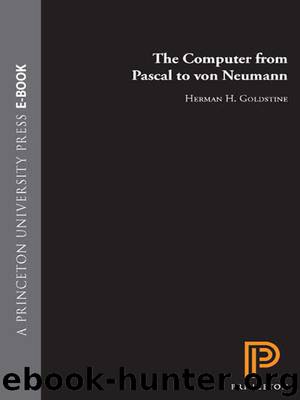The Computer from Pascal to Von Neumann by Goldstine Herman H.; Goldstine Herman H. H.;

Author:Goldstine, Herman H.; Goldstine, Herman H. H.;
Language: eng
Format: epub
Publisher: Princeton University Press
These few illustrations should serve to show the true situation: all members of the discussion group shared their ideas with each other without restraint and therefore all deserve credit. Eckert and Mauchly unquestionably led on the technological side and von Neumann on the logical. It has been said by some that von Neumann did not give credits in his First Draft to others. The reason for this was that the document was intended by von Neumann as a working paper for use in clarifying and coordinating the thinking of the group and was not intended as a publication. (In fact, on 25 June 1945 copies were distributed to 24 persons closely connected to the project.) Its importance was so clear however that later as its fame grew many outsiders requested copies from the Moore School or me. Through no fault of von Neumann’s the draft was never revised into what he would have considered a report for publication. Indeed, not until several years later did he know that it had been widely distributed.
Hopefully having laid that ghost to rest, we return to von Neumann’s contributions. First, his entire summary as a unit constitutes a major contribution and had a profound impact not only on the EDVAC but also served as a model for virtually all future studies of logical design. Second, in that report he introduced a logical notation adapted from one of McCulloch and Pitts, who used it in a study of the nervous system.21 This notation became widely used, and is still, in modified form, an important and indeed essential way for describing pictorially how computer circuits behave from a logical point of view.22
Third, in the famous report he proposed a repertoire of instructions for the EDVAC’, and in a subsequent letter he worked out a detailed programming for a sort and merge routine. This represents a milestone, since it is the first elucidation of the now famous stored program concept together with a completely worked-out illustration.
Fourth, he set forth clearly the serial mode of operation of the modern computer, i.e. one instruction at a time is inspected and then executed. This is in sharp distinction to the parallel operation of the ENIAC in which many things are simultaneously being performed.
Fifth, he gave clear indications that some modification of the so-called iconoscope or television camera tube would be a valuable memory device. This is a foreshadowing of the project at the Institute for Advanced Study which was to be the prototype for the computers of yesterday, today, and perhaps tomorrow.
These are the things von Neumann did. They have left their mark on the whole computing world. Thus, for example, the designers of the EDSAC, the first machine in the world to use the stored program, say: “Several machines working on the same principles as the EDSAC are now in operation in the United States and in England. These principles derive from a report drafted by J. von Neumann in 1946 [sic]…. It is found that machines designed along
Download
This site does not store any files on its server. We only index and link to content provided by other sites. Please contact the content providers to delete copyright contents if any and email us, we'll remove relevant links or contents immediately.
| Circuits | Digital Design |
| Electric Machinery & Motors | Electronics |
| Fiber Optics | Networks |
| Superconductivity |
Whiskies Galore by Ian Buxton(41875)
Introduction to Aircraft Design (Cambridge Aerospace Series) by John P. Fielding(33064)
Small Unmanned Fixed-wing Aircraft Design by Andrew J. Keane Andras Sobester James P. Scanlan & András Sóbester & James P. Scanlan(32743)
Craft Beer for the Homebrewer by Michael Agnew(18140)
Turbulence by E. J. Noyes(7935)
The Complete Stick Figure Physics Tutorials by Allen Sarah(7307)
Kaplan MCAT General Chemistry Review by Kaplan(6866)
The Thirst by Nesbo Jo(6826)
Bad Blood by John Carreyrou(6547)
Modelling of Convective Heat and Mass Transfer in Rotating Flows by Igor V. Shevchuk(6391)
Learning SQL by Alan Beaulieu(6209)
Weapons of Math Destruction by Cathy O'Neil(6142)
Man-made Catastrophes and Risk Information Concealment by Dmitry Chernov & Didier Sornette(5921)
Digital Minimalism by Cal Newport;(5662)
Life 3.0: Being Human in the Age of Artificial Intelligence by Tegmark Max(5474)
iGen by Jean M. Twenge(5366)
Secrets of Antigravity Propulsion: Tesla, UFOs, and Classified Aerospace Technology by Ph.D. Paul A. Laviolette(5309)
Design of Trajectory Optimization Approach for Space Maneuver Vehicle Skip Entry Problems by Runqi Chai & Al Savvaris & Antonios Tsourdos & Senchun Chai(5011)
Pale Blue Dot by Carl Sagan(4909)
